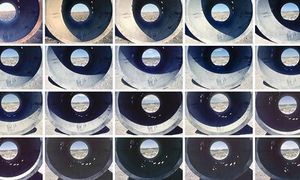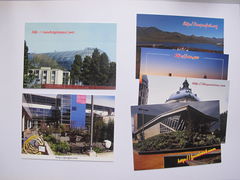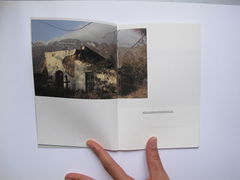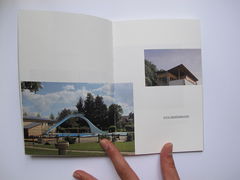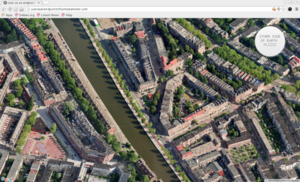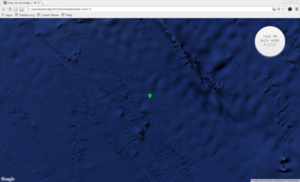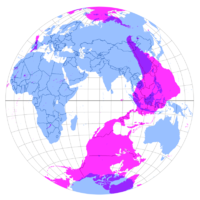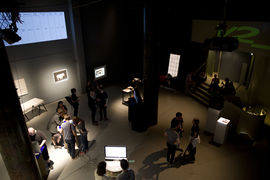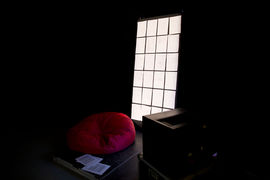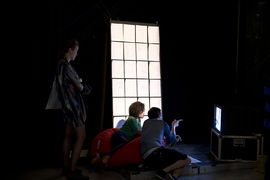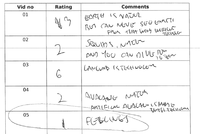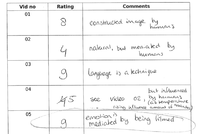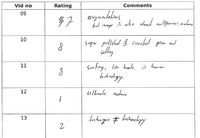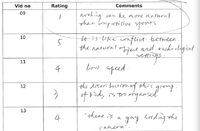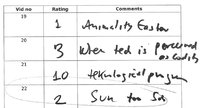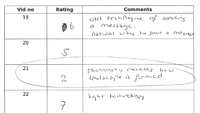User:Jules/graduationproposal
~(^=^~)
Introduction
My graduation project would consist in performing drawings of star constellations over the world with IP addresses on the basis of their geographical coordinates. Formally, this project was inspired by the Gallery Transplants made by Dennis Oppenheim in 1969. A Gallery Transplant consists in a transfer from the enclosed architectural and cultural space of the museum to an open exterior space. He applied the process to the Andrew Dickson White Museum and the Stedelijk Museum and transferred them respectively to the campus grounds of Cornwell University and Jersey city.
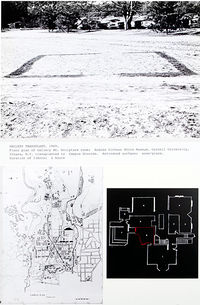
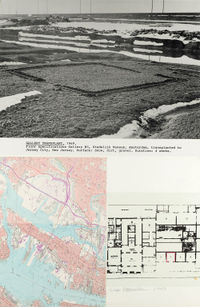
The plan of the galley's floor is drawn outside in the snow. The result is then presented with an official plan of the Gallery, a topographic map and a picture of the installation.
Robert Smithson referred to that work talking about “Dis-location” to qualify Oppenheim's process. To him Oppenheim operated in a Data transfer from a part of the world to another.[1]
Following the same logic as the Earth works, the execution of my project would be twofold. I would first perform the drawings, connecting points until the whole figure breaks down because of changes in the Network. Smithson described entropy as a condition that's irreversible, moving towards a gradual equilibrium.[2] This equilibrium consists in the continuity in the browsing experience of the Internet by its users, as discussed by Alexander R. Galloway in the chapter about Form of digital Networks in Protocols or how control exists after decentralization [3]
Thinking about the sun tunnels of Nancy Holt made me consider the mapping of star constellations, as an analogy with computer Network topologies. [4]
"It’s an inversion of the sky/ground relationship-bringing the sky down to the earth."
As an apparatus, the Sun Tunnels enables the connection between the two milieus by transferring information from one to the other.
Relation to previous practice
My previous practice is articulated around the process of mapping space and revealing invisible processes but also questioning the ways of creating such visualisations. The reflexivity on the tools is important to me because visualisations are performative and can determine our relationship to our close and distant environment. Another important thing about my work is that I never really consider my projects as formally set. I feel that they allow enough flexibility to allow different modes of presentation.
1. Browsed landscapes [5]
Browsed landscapes consists in a series of three projects like variations of the same process The different applications of the same operation can generate different highlights over the question of the place when it comes to the Internet's infrastructure outputs. The investigation was pursued over the Network with the tools I could find.
Demo on Max OS X using Google Chrome Browser
2. Userasanendpointofsomediameter [6]
With userasanenpointofsomediameter, I geolocated the user's position on Google maps and took him through a “fake tunnel” that would lead them to the antipodes of their position. Although the title suggests the World as a spherical geometrical shape, the whole process deploys itself over the flat surface of the screen. This paradox is also present within the tool used, the ubiquitous interface of Google maps is presenting to us a flattened vision of the world.
Nevertheless, within the API, I used the formula enabling to find a diameter's endpoint, in relation to any point over a circle's circumference.
var antipodes_lat = currentLatLng.lat() * -1;
var antipodes_lng = currentLatLng.lng() + 180;
3. It reminds me of a scene in Interstellar [7]
For the project “It reminds me if a scene in Interstellar”, I established a set of 25 videos that I found on youtube and which, to my opinion, could be ambiguous. The audio and titles were removed, to only focus on the visual content, outside its primary context. I wanted to have a certain amount to encourage people to not over think about them but give quite spontaneous opinions. Then, a panel of 17 volunteers have been asked to rate a set of 25 video extracts of 15 seconds each. The rating has been established on a scale from 1 to 10, where 1 corresponds to nature and 10 to technology. Sometimes, the volunteers explained the motivation behind the decisions they made. The average grades defined the positioning of the videos in the final montage. The result functions as a gradient, from one idea to the other.
The results I got were extremely variable from one person to another, underlining the difficult aspect of drawing a line between the two notions. The mental representation we have of what is natural and what is technological can conflict with the actual traces of human involvement to generate those representations.
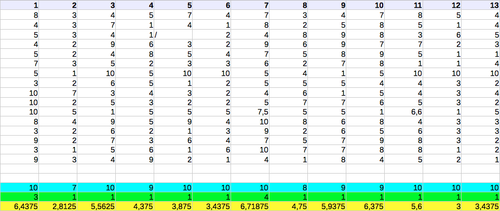
Cyan is the highest score (technology)
Green is the smallest (nature)
Yellow is the average (final position)
I asked for names and biographies because I thought that it would directly relate to the subjectivity in answers provided (a graphic designer and a nurse may not share the same view over what nature may look like, due to their education and activities)
I also specified that I wanted the sheets to be filled by hand to keep the trace of human labour involved.
Thesis intention and sort of Abstract for the context
I would like the thesis to reflect on my process. Making an installation within a networked environment necessitates to be mediated by means for spatial representation. Since the tools for mediation play a major part within the work, I will reflect on the implications and functioning of the tools used mapping. By doing so, they become narrative device and get re associated with the intentions of their creators and propagators. I think it will be also important to define what it means to locate and mediate physical locations through Digital Networks. Investigating the spatial properties of the Internet determine our relation to society and reflexively opens the reflection on what in means to inhabit space in the era of ubiquitous computer Networks.
Context
0. How could that be a relevant idea
“Our culture is undergoing a truly drastic change in terms of our physical and psychological relationship with space and other bodies.”'
Machiko Kusahara [8]
We move on the Internet and the Internet moves with us as we go outside with smart devices within our pocket, Yet it is hard to grasp what we move in relation to. Pictures of data centers and Geographical maps of submarine cables open up the conversation but yet the location of the digital informational content scattered over the Earth remains pretty invisible. My take is not to go towards an overly didactic orientation but to map for poetic visualization and imaginary topology. By doing so, I hope to counteract geographical mappings of Internet connections as objective matters of fact.
“As infrastructures become more transparent (and more reliable, affordable and universally available), so they morph in character from desired conveniences to a necessary and seemingly naturally-given part of the lived environment.”
Martin Dodge
The Internet is a very potent space and space's architecture shapes life within the society. Some very the concrete issues related to the application of power over individuals and spatial properties of Internet are intertwined. As the technology becomes naturalised and ubiquitous, it is embedded within the fabric of our environment. Yet, it remains hard to pin down its materiality and how they affect our relation to space, because of the lack of visibility of the infrastructure supporting them. By crossing information on physical locations and Internet content location, I hope to make the relation a bit more tangible. Geography is performative, it shapes our perception of the place we inhabit by writing invisible phenomenons. Its devices can be given a twist to narrate other potential stories and make us reconsider how we perceived it (or not even question this perception by tactical lack of curiosity).
One may argue that this general lack of curiosity comes from a lack of interest in the topic. I feel that it is quite the opposite but it needs to be visible to be perceived as interesting. Showing such information usually triggers positive responses, such as the one of this writer called Mark Wilson [9] after discovering Silvio Larusso's Data Center Grand Tour[10].
1. Acting in the environment
"The act of “surfing the Web,” which, phenomenologically, should be an unnerving experience of radical dislocation—passing from a server in one city to a server in another city—could not be more pleasurable for the user. Legions of computer users live and play online with no sense of radical dislocation. Continuity, then, is defined as the set of techniques practiced by web- masters that, taken as a totality, create this pleasurable, fluid experience for the user. As a whole they constitute a set of abstract protocological rules for the application layer."
Alexander Galloway
As fore mentioned, this installation would be subject to Entropy. That, because locations rely on hardware facilities, scattered over a distance that is out of my personal reach. The machines get connected to a wider Network (the Internet), and eventually disconnect for several potential reasons. While Oppenheim's Transplants consisted in a linear translation of information, from a point A to a point B yet over the same scale, drawing with Networks constitutes more of a proportional expansion over a wider scale that is not territorially enclosed. In this particular case, we are physically excluded from the environment where the installation happens. The failure to maintain the work on a long time scale which is to be expected underlines the material specificities of digital Networks. It is also an act of resistance against the sensation of smooth continuity enhanced by protocols. The functioning of the most powerful infrastructure supporting our lives are invisible until they let us down. This notion is also present in the recently unveiled A quiet desert failure[11] by Guido Segni which automates the transfer of Google's satellite images from the Sahara desert to Tumblr's data servers.
“The whole performance will approximately take 50 years to be completed, but it is still not clear if the audience, the Google’s servers, the tumblr archive or the Internet itself will last enough to see the end.”
Guido Segni
2. Capturing on a global scale
One of the many reasons of my interest for the Environmental movement of the 60s is that it was made possible by the emergence of technologies enabling its capture and mediation within the Art's ecosystem, alongside geographical plotting. It was very much concerned with the way in which we inhabit society and construct our perception of space. This reterritorialisation process, or variability, is crucial for the good understanding of the spatial dimension of the piece. The margin for variability that I like to allow within my projects is something that makes me relate a lot to Robert Smithson. In the case of Spiral Jetty (1970) for instance, Smithson considered that the work had three manifestations under the same name, and that each of them constitutes a work in its own right. Those consist in the outdoor installation at Rozel point in the Great Salt Lake (Utah), the film and an essay.. To Smithson, the sculpture was occupying a Site, while the film and the essay constituted non-sites. Language (the essay), photographic images (the film), and earth (the jetty) were considered by Smithson as materials of equal values. This approach is certainly informed by the aforementioned notions of entropy and scale/location of the work. Interestingly, the different material used can contrast with each other in terms of their capacity to endure time and space. With this in mind, I think that the same approach with the use of digital means for capturing the land may highlight their specificities.
3. The map and the land
“The relation of a Nonsite to the Site is also like that of language to the world: it is a signifier and the Site is that which is signified.”
Robert Smithson
"All world maps are semiotically frontier signs, on the ground, the frontier line is not physically traceable yet maps have a performative action in the construction of territory"
Martin Dodge
In the Earthworks, the use of maps to illustrate the concepts is a very usual practice. The dialogue between the two had been even sometimes triggered in reverse. With The California Map project, John Baldessari, repositioned the letters indicating California at the precise locations on which they were indicated on the map. (This is comparable to Aram Bartholl's Google Maps project). The map materialises into the land. The ethereal Internet space is in a relationship with the terrestrial.Not all the content available online can cross geographical borders. We use Google satellite navigation to not need to ask people, save time on journey planing and find the closest supermarket still opened past 8pm. We are traceable, captured by the map, and the things that aren't remain in a blind spot [12].
The multiplicity of artistic practices dealing with Google maps should also be an indicator of the power such map has on forming its users vision of the world they live in.The video piece entitled Farm by John Gerrard addresses the control over the representation of Google's Data centre. The artist contacted Google to make picture of its farm in Oklahoma, request to which was given a negative answer.[13]
According to Geert Lovink: “Richard Rogers suggests that mapping networks, especially as an intelligence task, carries with it more than just an aesthetic outcome; we are in the midst of a techno-pistemological impulse in which the form(at) of the map has a structuring effect on how we understand the organisation (structure) and dynamics (movement) of networks (2003).” Drawing a shape over a map creates a spatial delineation that is then associated with the idea that something is located somewhere at a particular place. Networks landmarks over a map, map that we regard as the frame for the world we inhabit, it includes something to the realm as we accept them as facts.
Practical steps
At the moment, I am getting more familiar with the tools. I am using a MongoDB version of the MaxMind GeoIP legacy database. I have exported some json files compiling all the relevant data on Latitude and Longitude criteria. I need to make more complex requests soon, such as precise geometrical shapes, and start experimenting with the plotting. I may start visualising the locations with Google Maps for a first draft but I would like to be able to cross with other types of maps.
After Christmas, I will work on using IP addresses extracted on the basis of Geographic criteria to find websites, so I could spatially recontextualise information and location.
Then I will be able to work on prototypes showing information alongside location.
Regarding the documentation of my working process, I will try to build on the things I have developed over the last year.
Firstly, I have adapted the interface of a very simple cms which I can update it from my computer over my server thanks to Git. It functions as a notebook which helps me keep a trace of what I have been reading. It is quite flexible and I try to add pads next to my notes in case I ever want to cross references.
→ http://pzi.here-you-are.com/notebook/ .
I have prepared the same system to have a set of images I can refer to (although I have been very bad at updating it so far).
→ http://pzi.here-you-are.com/imgdir/
Sometimes, when investigating a specific topic, I also write a text as it helps me assimilate information that I have been gathering and and associate facts together. This practice often goes alongside making practical sketching experiments such as the following ones :
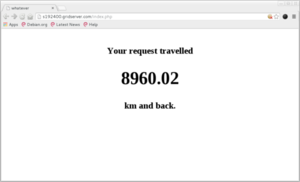
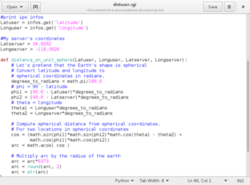
https://pzwiki.wdka.nl/mediadesign/User:Jules/opticsofdatatransmission
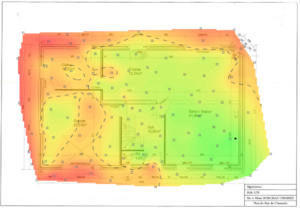
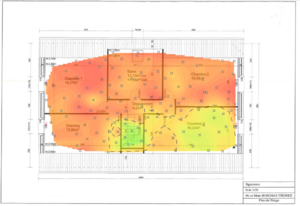
https://pzwiki.wdka.nl/mediadesign/User:Jules/wifiheatmap
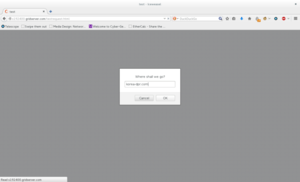
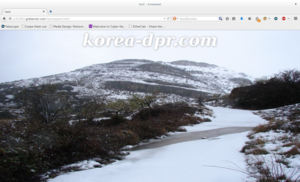
http://pzwiki.wdka.nl/mediadesign/User:Jules/geoipdatabases
References
For actual set of references, or just things that trigger my interest, please see:
http://pzi.here-you-are.com/notebook/
The notebook contains etherpads on which anyone can add thoughts or references they feel like doing such
http://pzi.here-you-are.com/imgdir/
And this is a little list of things I need to investigate soon :
- Simulacra and simulation, 1994, Baudrillard
Today abstraction is no longer that of the map, the double, the mirror, or the concept. Simulation is no longer that of a territory, a referential being or substance. It is the generation by models of a real without origin or reality: A hyperreal. The territory no longer precedes the map, nor does it survive it. It is nevertheless the map that precedes the territory - precession of simulacra - that engenders the territory.
- Steps to an ecology of the mind, 1972 Gregory Bateson:
We say the map is different from the territory. But what is the territory? Operationally, somebody went out with a retina or a measuring stick and made representations which were then put on paper. What is on the paper map is a representation of what was in the retinal representation of the man who made the map; and as you push the question back, what you find is an infinite regress, an infinite series of maps. The territory never gets in at all. The territory is Ding an sich and you can't do anything with it. Always, the process of representation will filter it out so that the mental world is only maps of maps, ad infinitum.
- From Psychogeography to Cybertopology; 2006, Sher Doruff
(dis)Orienting Place : Performing “ place” through purposeful disorientation was the aesthetic of early Situationist dérives. Today the technological accoutrement for triangulated, coordinate spe-cific, Cartesian orientation is apparent in many current locative projects. Aesthetic practice accessed through a network of military satellites has détourned the dérive signifi-cantly. The shapeshift between discipline and control, between game and play, is felt in the relation between orientation and disorientation.
- Smooth and striated space, 1972, A thousand plateaux
- Entropy made visible, 1973, Robert Smithson
De-architecture : Architects never seem to allow for any kind of relationship outside their own plans, same with economics. They expect to be isolated and self-contained, conceived as cycles to exclude the entropic process.
- GPS Errors and Pilgrimage to Lourde, 2010, Benjamin Mako Hill
http://revealingerrors.com/lourdes_gps
———??? “Architecture is an art of distinctions within the continuum of space.” (W.J. Mitchell, The Logic of Architecture, p.1)
- ↑ (1)Lisa Bear et Willoughby Sharp, "Discussions with Heizer, Oppenheim, Smithson (1970)", In : Robert Smithson : The Collected Writings, Berkeley, Los Angeles, London, University of California Press, 1996, p. 244.
- ↑ Entropy made visible, 1973
- ↑ 2004, p 68 “All technology is new technology. Everything else must be eliminated. Dead media are those media that have fallen out of use. They include everything from dead hardware (Commodore 64, Apple II) to dead computer languages (Fortran, Cobol) to dead media formats (Sony Betamax, 8-track cassette). Dead media means discontinuity. Dead media do not function within contemporary network flows; therefore, they have no place.”
- ↑ https://pzwiki.wdka.nl/mediadesign/User:Jules/linkingdots
- ↑ http://pzwiki.wdka.nl/mediadesign/User:Jules/browsedlandscapes
- ↑ http://userasanendpointofsomediameter.com/
- ↑ http://pzwiki.wdka.nl/mediadesign/User:Jules/remindsmeofinterstellar
- ↑ “Presence, Absence, and Knowledge in Telerobotic Art,” in The Robot in the Garden, 2001
- ↑ "Seeing the entire exhibition takes all of 30 seconds if you click quickly, but it will inevitably leave your perspective changed. Because even though we all know that the Internet spans the world, our browsers render it as an experience all of 13 inches wide on a laptop screen, with no image, video, or article more than a few keystrokes or clicks away. Our feedback for this exploration is wholly positive in nature—we’re constantly rewarded with content at no real cost, like children who understand the concept of money but have absolutely no concern as to how their parents make it."
http://www.fastcodesign.com/1671946/see-where-websites-live - ↑ https://www.youtube.com/watch?v=3YSWXHUAG4A
- ↑ http://desert.fail/ure/
- ↑ https://en.wikipedia.org/wiki/Satellite_map_images_with_missing_or_unclear_data
- ↑ http://www.theguardian.com/artanddesign/2015/feb/04/google-data-farm-john-gerrard-internet-art

